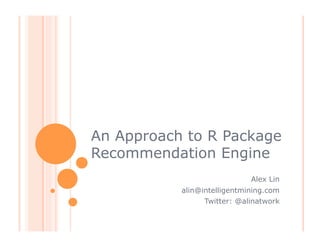An Approach to R Package Recommendation Engine
•
2 likes•1,905 views
To download the slides please go here: http://www.intelligentmining.com/category/knowledge-base/ Alex's approach to the R package recommender system Kaggle competition, where he placed 4th. Slides presented to NYCPA.
Report
Share
Report
Share

Recommended
Recommended
More Related Content
Recently uploaded
Recently uploaded (20)
The Zero-ETL Approach: Enhancing Data Agility and Insight

The Zero-ETL Approach: Enhancing Data Agility and Insight
Event-Driven Architecture Masterclass: Challenges in Stream Processing

Event-Driven Architecture Masterclass: Challenges in Stream Processing
Observability Concepts EVERY Developer Should Know (DevOpsDays Seattle)

Observability Concepts EVERY Developer Should Know (DevOpsDays Seattle)
How to Check CNIC Information Online with Pakdata cf

How to Check CNIC Information Online with Pakdata cf
Long journey of Ruby Standard library at RubyKaigi 2024

Long journey of Ruby Standard library at RubyKaigi 2024
State of the Smart Building Startup Landscape 2024!

State of the Smart Building Startup Landscape 2024!
Event-Driven Architecture Masterclass: Integrating Distributed Data Stores Ac...

Event-Driven Architecture Masterclass: Integrating Distributed Data Stores Ac...
Intro to Passkeys and the State of Passwordless.pptx

Intro to Passkeys and the State of Passwordless.pptx
ChatGPT and Beyond - Elevating DevOps Productivity

ChatGPT and Beyond - Elevating DevOps Productivity
Continuing Bonds Through AI: A Hermeneutic Reflection on Thanabots

Continuing Bonds Through AI: A Hermeneutic Reflection on Thanabots
Event-Driven Architecture Masterclass: Engineering a Robust, High-performance...

Event-Driven Architecture Masterclass: Engineering a Robust, High-performance...
Design and Development of a Provenance Capture Platform for Data Science

Design and Development of a Provenance Capture Platform for Data Science
Revolutionizing SAP® Processes with Automation and Artificial Intelligence

Revolutionizing SAP® Processes with Automation and Artificial Intelligence
Featured
Featured (20)
How Race, Age and Gender Shape Attitudes Towards Mental Health

How Race, Age and Gender Shape Attitudes Towards Mental Health
AI Trends in Creative Operations 2024 by Artwork Flow.pdf

AI Trends in Creative Operations 2024 by Artwork Flow.pdf
Content Methodology: A Best Practices Report (Webinar)

Content Methodology: A Best Practices Report (Webinar)
How to Prepare For a Successful Job Search for 2024

How to Prepare For a Successful Job Search for 2024
Social Media Marketing Trends 2024 // The Global Indie Insights

Social Media Marketing Trends 2024 // The Global Indie Insights
Trends In Paid Search: Navigating The Digital Landscape In 2024

Trends In Paid Search: Navigating The Digital Landscape In 2024
5 Public speaking tips from TED - Visualized summary

5 Public speaking tips from TED - Visualized summary
Google's Just Not That Into You: Understanding Core Updates & Search Intent

Google's Just Not That Into You: Understanding Core Updates & Search Intent
The six step guide to practical project management

The six step guide to practical project management
Beginners Guide to TikTok for Search - Rachel Pearson - We are Tilt __ Bright...

Beginners Guide to TikTok for Search - Rachel Pearson - We are Tilt __ Bright...
Unlocking the Power of ChatGPT and AI in Testing - A Real-World Look, present...

Unlocking the Power of ChatGPT and AI in Testing - A Real-World Look, present...
An Approach to R Package Recommendation Engine
- 1. An Approach to R Package Recommendation Engine Alex Lin alin@intelligentmining.com Twitter: @alinatwork
- 2. Initial Thoughts The data set expected to have very strong package-package relationships (dependencies and related package functionalities). The data set (training + test) is not sparse. Most of matrix factorization (MF) techniques in the recommender field optimize square errors on the predicted user ratings not directly optimize for AUC.
- 3. Steps Modified k-Nearest Neighbor algorithm. User average & package average as prior bias. User-specific package Maintainer Affinity. Matrix factorization (MF) to post-process the residuals. Other rules.
- 4. Modified k-Nearest Neighbor algorithm Calculate cosine similarity for each pkg-pkg pair. Scale the cosine similarity with “square user support” ie. cosine * (support / ttl_user_cnt)**2 Unlike the regular kNN that is only additive, we use the same kNN rules to penalize the package if other related package was not installed. For unknown records, we choose to take ZAN approach. We treat the unknown entries as negative. k=all
- 5. User average and Package average as prior bias User average = user installed pkg count / user observation count Package average = pkg installed by users count / pkg observation count Add them into the kNN result score.
- 6. User-specific Package Maintainer Affinity This metric measured as the installed package percent of a given maintainer for an user. We use the percentage to predict how likely the user will install the other package from the same maintainer. Combine with kNN result score with weight of 0.25.
- 7. So Far – baseline model Very heuristic Public AUC = 0.976x
- 8. Matrix Factorization Analyze the residuals only. The goal is to find out structural errors in our baseline prediction. prediction := baseline_output + residual residual := pkg_bias + user_bias + pkgFactors . userFactors residuals is related to Wilcoxon-Mann-Whitney (WMW) statistics
- 9. Matrix Factorization – cont. Minimizes truncated square error with batch gradient descent (BGD) Pairwise comparison
- 10. Other Rules For those duplicate records found exist in both testing and training set, copy answers from training set. Assume when a user install a package P, the user also installs the packages that P depends on.
- 11. Final Result Public AUC = 0.984914 Final AUC = 0.979565
Editor's Notes
- AUC = 0.85
- AUC = 0.95x
- Xui is residual and Residual = pkg_bias + user_bias + (pkgFactors . userFactors)
- Xui is residual and Residual = pkg_bias + user_bias + (pkgFactors . userFactors)
- Xui is residual and Residual = pkg_bias + user_bias + (pkgFactors . userFactors)
